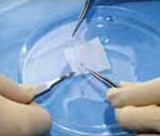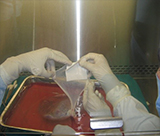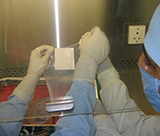


Amniotic membrane Grafting in progress
Amniotic membrane is the innermost lining of the placenta. This lining serves as a natural barrier to protect the fetus from potential bacterial and viral infections. Amniotic membrane has natural biological properties that prevent scarring, reduce inflammation, stop the formation of blood vessels and promote wound healing.
Use of amniotic membrane in eye surgery
Amniotic membrane is ideal for use in eye surgery because, it has very similar biological and physical properties to the tissue on ones eye surface. Amniotic membrane is a biological tissue which has been used for variety of ophthalmic indications. Some of these indications include persistent epithelium defect, neurotrophic ulcer, chemical burns of the eye and covering of the defect following removal of large ocular surface tumour.
Amniotic membrane transplantation (AMT) in ophthalmology
The amniotic membrane, or amnion, comprises the innermost layer of the placenta. Amniotic membrane has been used in different types of reconstructive surgeries.AMT is important because of its ability to diminish the occurrence of adhesions and scarring, its ability to enhance wound healing and epithelialization, and its antimicrobial potential.
Use In Ophthalmology
Amniotic membrane can be used in number of indications, either as a ‘substrate’ to replace the damaged ocular tissue or as a ‘patch’ (biological dressing), or a combination of both .
It is useful for following diseases:
A) Corneal diseases: Persistent epithelial defects, Corneal ulceration, Symptomatic bullous keratopathy, Persistent Epithelial Defects, Corneal Ulcers (central or peripheral), Descematocele or Perforation, Band Keratopathy, After Corneal Scar Removal, Chemical injury.
B) Conjunctival diseases: Stevens-Johnson Syndrome, Conjunctival cicatrization / scar, Symblepharon lysis, Conjunctivochalasis, Conjunctival surface reconstruction, Pterygium surgery, Trabeculectomy: bleb leakage or revision, Primary & Recurrent Pterygium, Pingueculae, Tumours, Superior Limbic Keratoconjunctivis, Scars.
C) Other Applications: Leaking Blebs, Scleral Melt, Limbal Stem Cell Deficiency, Fornix Reconstruction, Socket Reconstruction, High-Risk PKP, Chemical Burns, Stevens-Johnson Syndrome, Pemphigoid
The Amniotic Membrane grafting has been progressing at a steady pace at EBCRC. Having seen the demands it was decided to acquire the equipment for independent functioning for AMG..
The equipment is a (-80 C – Deep Freezer with 50 ltrs. Capacity, Digital electronic Micro Balance with accuracy of 0.00001 microgram, digital Ph-meter, Filtration Unit, Vacuum Pump, Glassware, Stainless Steel materials and other consumables.
We have been receiving requests for AMG from different parts of the country The Request for AMG has been showing an upward trend and we have so far distributed 1790 AMG.
With better awareness about availability of AMG amongst ophthalmic surgeons we are sure that this project will grow in a big way.